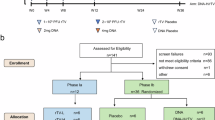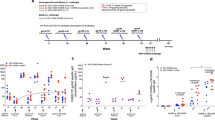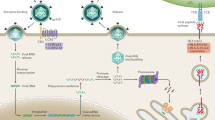Abstract
Novel approaches for the generation of more effective vaccines for HIV-1 are of significant importance. In this report we analyze the immunogenicity and efficacy of an HIV-1 DNA vaccine encoding env, rev and gag/pol in a chimpanzee model system. The immunized animals developed specific cellular and humoral immune responses. Animals were challenged with a heterologous chimpanzee titered stock of HIV-1 SF2 virus and followed for 48 weeks after challenge. Polymerase chain reaction coupled with reverse transcription (RT-PCR) results indicated infection in the control animal, whereas those animals vaccinated with the DNA constructs were protected from the establishment of infection. These studies serve as an important benchmark for the use of DNA vaccine technology for the production of protective immune responses.
This is a preview of subscription content, access via your institution
Access options
Subscribe to this journal
Receive 12 print issues and online access
$259.00 per year
only $21.58 per issue
Buy this article
- Purchase on SpringerLink
- Instant access to full article PDF
Prices may be subject to local taxes which are calculated during checkout
Similar content being viewed by others
References
Haynes, B.F., Pantaleo, C.,& Fauci, A.S. Toward an understanding of the correlates of protective immunity to HIV infection. Science 271, 324–328 (1996).
Pantaleo, G. et al. Studies in subjects with long-term nonprogressive human immunodeficiency virus infection. N. Engl. J. Med. 332, 209–216 (1995).
Rinaldo, C. et al. High levels of anti-human immunodeficiency virus type 1 (HIV-1) memory cytotoxic T-lymphocyte activity and low viral load are associated with lack of disease in HIV-1 infected long-term nonprogressors. J. Virol. 69, 5838–5842 (1995).
Rowland-Jones, S. et al. HIV-specific cytotoxic T-cells in HIV-exposed but uninfected Gambian women. Nature Med. 1, 59–64 (1995).
Rowland-Jones, S., Nixon, D. & Aldhous, M. HIV-specific cytotoxic T-cell activity in an HIV-exposed but uninfected infant. Lancet 341, 860–861 (1993).
Ugen, K.E. et al. Verticaltransmissionofimmunodeficiency virus type 1: Seroreactivity by maternal antibodies to the carboxy region of the gp41 envelope. J. Infect. Dis. 175, 63–69 (1997).
Ugen, K.E. et al. Vertical transmission of human immunodeficiency virus (HIV) infection: Reactivity of maternal sera with glycoprotein 120 and 41 peptides from HIV type 1. J. Clin. Invest. 89, 1923–1930 (1992).
Rossi, P. et al. Presence of maternal antibodies to human immunodeficiency virus 1 envelope glycoprotein gpl 20 epitopes correlates with the uninfected status of children born to seropositive mothers. Proc. Not. Acad. Sci. USA 86, 8055–8058 (1989).
Goedert, J. et al. Mother-to-infant transmission of human immunodeficiency virus type 1: Association with prematurity or low anti-gp!20. Lancet 2, 1351–1354 (1989).
Dubensky, T., Campell, B. & Villarreal, L. Direct transfection of viral and plasmid DNA into the liver of spleen of mice. Proc. Natl. Acad. Sci. USA 81, 7529–7533 (1984).
Raz, E. et al. Systemic immunological effects of cytokine genes injected into skeletal muscle. Proc. Natl. Acad. Sci. USA 90, 4523 (1993).
Wolff, J.A. et al. Direct gene transfer into mouse muscle in vivo. Science 247, 1465–1468 (1990).
Wang, B. et al. Immunization by direct DNA inoculation induces rejection of tumor cell challenge. Hum. Gene Ther. 6, 407–418 (1995).
Ulmer, J.B. et al. Heterologous protection against influenza by injection of DNA encoding a viral protein. Science 259, 1745–1749 (1993).
Tang, D.C., Devit, M. & Johnston, S.A. Genetic immunization is a simple method for eliciting an immune response. Nature 356, 152–154 (1992).
Michel, M.L. et al. DNA-mediated immunization to the hepatitis B surface antigen in mice: Aspects of the humoral response mimic hepatitis B viral infection in humans. Proc. Natl. Acad. Sci. USA 92, 5307–5311 (1995).
Lowrie, D.B., Tascon, R.E., Colston, M.J. & Silva, C.L. Towards a DNA vaccine against tuberculosis. Vaccine 12, 1537–1540 (1994).
Barry, M., Lai, W. & Johnston, S. Protection against mycoplasma infection using expression-library immunization. Nature 377, 632–635 (1995).
Fynan, E.F., Webster, R.G., Fuller, D.H. & Haynes, J.R. DNA vaccines: Protective immunizations by parental, mucosal and gene-gun inoculations. Proc. Natl. Acad. Sci. USA 90, 11478–11482 (1993).
Wang, B. et al. DNA inoculation induces protective in vivo immune responses against cellular challenge with HIV-1 antigen-expressing cells. AIDS Res. Hum. Retroviruses 10 (Suppl. 2), S35–S41 (1994).
Wang, B. et al. DNA Inoculation induces cross clade anti-HIV-1 responses. Ann. NY Acad. Sci. 772, 186–197 (1995).
Wang, B. et al. Induction of humoral and cellular immune responses to the human immunodeficiency virus type 1 in non-human primates. Virology 221, 102–112 (1995).
Wang, B. et al. Gene inoculation generates immune responses against human immunodeficiency virus type 1. Proc. Natl. Acad. Sci. USA 90, 4156–4160 (1993)
Boyer, J.D. et al. In vivo protective anti-HIV immune responses in non-human primates through DNA immunization. J. Med. Primatol. 25, 242–250 (1996).
Lu, S., Santoro, J.C., Fuller, D.H., Haynes, J.R. & Robinson, H.L. Use of DNAs expressing HIV-1 envand non-infectious HIV-1 particles to raise antibody responses in mice. Virology 209, 147–154 (1995).
Haynes, J.R., Fuller, D.H., Eisenbraun, M.D., Ford, M.J., Pertmer, T.M. Accell→ particle-mediated DNA immunization elicits humoral, cytotoxic and protective responses. AIDS Res. Hum. Retrovlruses 10 (Suppl. 2), S43–S45 (1994).
Okuda, K. et al. Induction of potent humoral and cell-mediated immune responses following direct injection of DNA encoding the HIV type 1 env and rev gene products. AIDS Res. Hum. Retroviruses 11, 933–943 (1995).
Lu, S. et al. Simian Immunodeficiency virus DNA vaccine trial in macaques. J. Virol. 70, 3978–3991 (1996).
Muster, T. et al. A conserved neutralizing epitope on gp41 of human immunodeficiency virus type 1. Virol. 11, 6642–6647 (1993).
Vandamme, A.-M. Polymerase chain reaction (PCR) as a diagnostic tool in HIV infection. Verh. K. Acad. Geneeskd. Belg. 3, 231–265 (1994).
Vandamme, A.-M. et al. Detection of HIV-1 RNA in plasma and serum samples using the NASBA amplification system compared to RNA-PCR. J. Virol. Methods 52 121–132 (1995).
Shibata, R. et al. Resistance of previously infected chimpanzees to successive challenges with a heterologous intraclade B strain of human immunodeficiency virus type 1. J. Virol. 70, 4361–4369 (1996).
Lane, H.C., Depper, J.M., Greene, W.C., Whjalen, C., Waldmann, T.A. & Fauci, A.D. Qualitative analysis of immune function in patients with the acquired immunodeficiency syndrome: Evidence for a selective defect in soluble antigen recognition. N. Engl. J. Med. 313, 79–84 (1985).
Gruters, R.A. et al. Selective loss of T cell functions in different stages of HIV infection, fur. J. Immunol. 20, 1038–1044 (1990).
Vingerhoets, J.H. et al. Increased cytolytic T lymphocyte activity and decreased B7 responsiveness are associated with CD28 down-regulation on CD8+ T cells from HIV-infected subjects. Clin. Exp. Immun. 100, 425–433 (1995).
Levine, B.L. et al. Antiviral effect and ex vivo CD4 T cell proliferation in HIV-positive patients as a results of CD28 costimulation. Science 272, 1939–1943 (1996).
Brinchmann, J.E. et al. Expression of costimulatory molecule CD28 on T cells in human immunodeficiency virus type 1 infection: Functional and clinical correlations. J. Infect. Dis. 169, 730–738 (1993).
Ho, D.D. et al. Rapid turnover of plasma virions and CD4+ lymphocytes in HIV-1 infection. Nature 373, 123–126 (1995).
Wei, X. et al. Viral dynamics in human immunodeficiency virus type 1 infection. Nature 373, 117–122 (1995).
Montifiori, D.C., Robinson, W.E., Schiffmann, S.S. & Michell, W.M. Evaluation of antiviral drugs and neutralizing antibodies to human immunodeficiency virus by a rapid and sensitive microtiter infection assay. J. Clin. Invest. 6, 231–235 (1988).
Author information
Authors and Affiliations
Rights and permissions
About this article
Cite this article
Boyer, J., Ugen, K., Wang, B. et al. Protection of chimpanzees from high-dose heterologous HIV-1 challenge by DNA vaccination. Nat Med 3, 526–532 (1997). https://doi.org/10.1038/nm0597-526
Received:
Accepted:
Issue date:
DOI: https://doi.org/10.1038/nm0597-526
This article is cited by
-
Monkeying around with HIV vaccines: using rhesus macaques to define 'gatekeepers' for clinical trials
Nature Reviews Immunology (2009)
-
Strategies for enhancing DNA vaccine potency by targeting antigen-presenting cells
Frontiers of Agriculture in China (2009)
-
DNA vaccines: developing new strategies to enhance immune responses
Immunologic Research (2008)
-
Enhanced Cellular Immune Responses Elicited by an Engineered HIV-1 Subtype B Consensus-based Envelope DNA Vaccine
Molecular Therapy (2007)
-
Combination DNA plus protein HIV vaccines
Springer Seminars in Immunopathology (2006)



